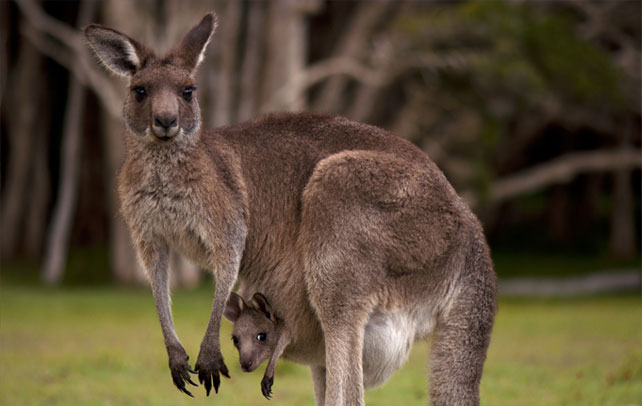Fun Facts About Kangaroo

Island habitats, isolated for millions of years, develop strange animals because of evolution and Australia perhaps has the most famous of these creatures. The kangaroo, which can be said to be the national symbol of the country, has never failed to fascinate mankind. Early explorers were dumbfounded by this strange creature that looked like an upright standing deer and hopped at amazing speed. What is more interesting is that unlike other animals, the female kangaroo carried its young in a pouch in its belly. Kangaroos are able to stand upright because they have an extremely strong, thick tail that they use as a third leg to balance themselves. Their hind legs are very powerful, which they use to hop or land vicious kicks to their adversaries. Of all the marsupials, kangaroos are the largest and the most well known. To know more about these extraordinary animals, explore the interesting and amazing facts. Continue reading.
Fast Facts
Kingdom: Animalia
Phylum: Chordata
Class: Mammalia
Infraclass: Marsupialia
Order: Diprotodontia
Family: Macropodidae
Genus: Macropus
Subgenus: Macropus and Osphranter
Type: Marsupial
Origin: Australia
Diet: Herbivorous
Size: Up to 6 feet
Weight: Up to 90 kg
Lifespan: 6 years in the wild
Habitat: Forest, grasslands and scrubland
Gestation Period: 33 days
Number of Offspring: One
Interesting And Fun Facts About Kangaroo
- The kangaroo is the national symbol of Australia and its image is used in some currencies. The kangaroo represents the country’s progress as the animal does not have the capacity to move backwards and always moves forward.
- Belonging to the Macropodidae family, kangaroos are the largest marsupial mammals.
- Generally, most kangaroos cannot move their hind legs one at a time and so they have to move both the legs together. As a result, the animals move by hopping, reaching at a speed averaging about 40 km/hr. Hopping is fast and energy efficient and kangaroos can travel large distances in this way. They are the only large animals that move by hopping. To move at a slow speed, it raises its self-up with its two forelimbs and tail and then brings its hind feet forward.
- They are excellent swimmers and when threatened will readily take to water. It is said that if any predator pursues the kangaroo into water, it will hold the predator down with its forepaws to drown it.
- Kangaroos generally do not require much water to survive and can go on for months without drinking. Their chief diet consists of grass, leaves and young shoots.
- The male kangaroo is called a buck and the locals call it “boomer” or “old man”. The females are called doe or flyer and the baby is called joey.
- Kangaroos can move their large ears in all direction to catch sounds. Along with their excellent sense of hearing, they also have good eyesight, but can respond only to moving objects.
- They are very sociable animals living in groups called mobs. The number of individual in a mob can vary from two or three to about a hundred individuals.
- The heaviest marsupial in the world is the Eastern Grey Kangaroo while the largest is the Red Kangaroo. The Red Kangaroo can grow to a height of 6 feet and weigh approximately 84 kg.
- Just like cattle, kangaroos have chambered stomach. So, they can regurgitate their food, chew, and swallow it for final digestion.
- Some species of kangaroos are nocturnal foraging for food at night while some are crepuscular, active during twilight. During the day, most of them spend their time resting in the shade.
- There is a myth that the name “kangaroo” originated because of a misunderstanding. According to the myth, when European explorers first saw these strange animals they asked an aborigine what they are called. The native said “kangaroo”, which meant “I don’t understand” and the explorers thought that was the animals name and it stuck. The fact is that the name originated from the aboriginal word “gangurru” referring to the Grey Kangaroo. Captain James Cook’s botanist first recorded it as “kangaroo”.
- Female kangaroos carry their young in a pouch for 8 to 10 months. They give birth to one young but can carry a joey and a newborn in the pouch while having a fecundated egg in the womb. After birth, the newborn, which is both deaf and blind, can smell its way from the cloaca to the pouch by following a trail of saliva that the female makes. The female has four mammary glands in the pouch and the offspring attaches to one of them. Since the baby cannot suckle, the mother pumps the milk into its mouth.
- Even when the baby has grown up it will suckle. That is why the mother produces two types of milk—one for the baby and one for the youngster.









